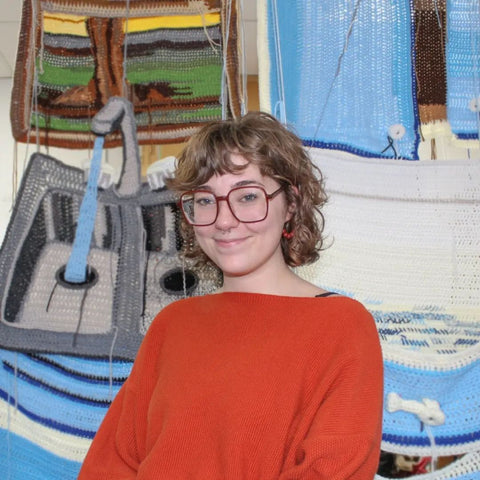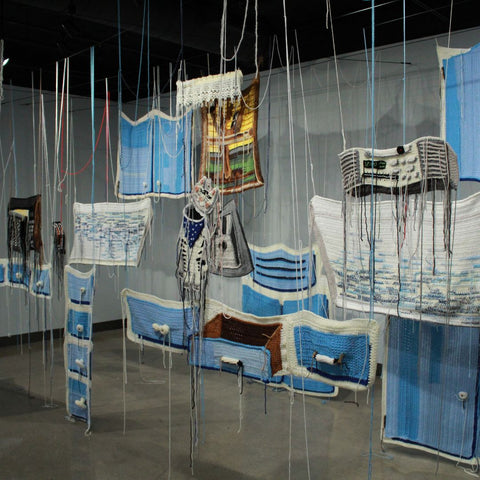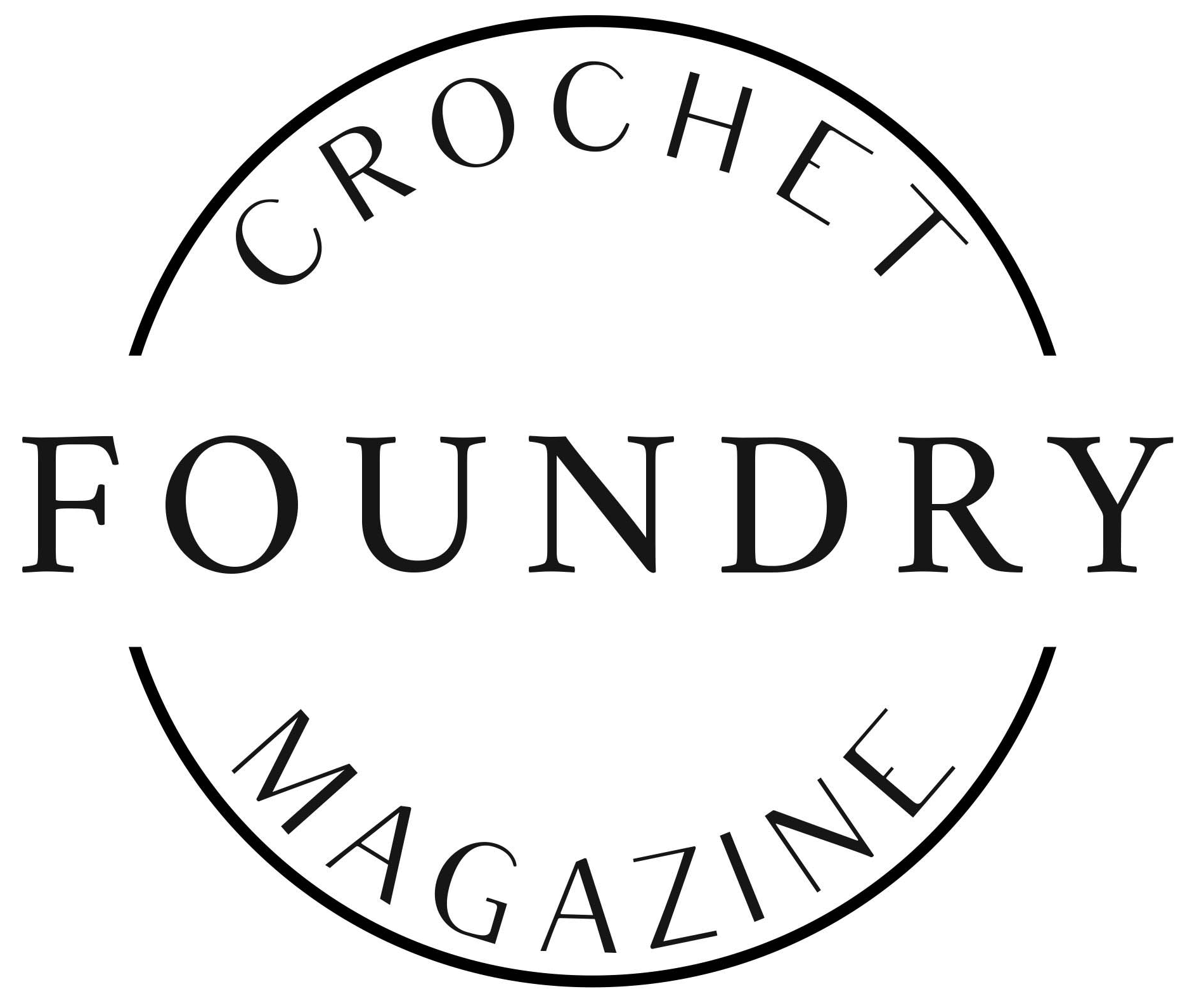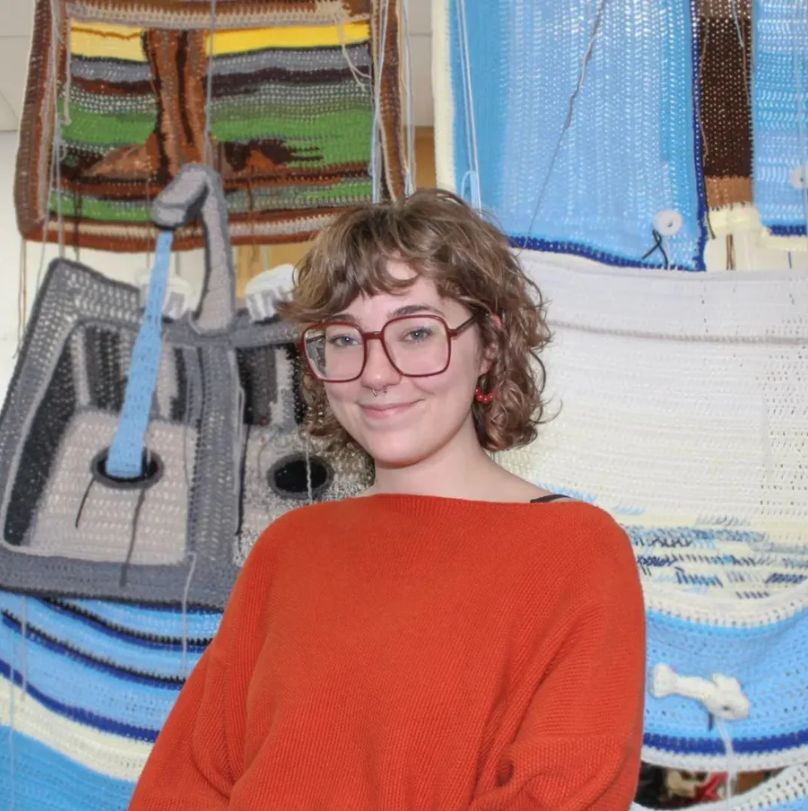Meet Baylee Schmitt, an artist with a penchant for crochet and a knack for blending tradition with contemporary art. From oil painting to needlepointing, Baylee’s creative journey led her to crochet, where she found a unique medium of expression. In this interview, she shares insights into her recent crochet installations, memories, and the delightful challenges of combining a traditional craft with the formal art world.

Tell us a bit about your crafty/crochet background. How did you learn to crochet?
I’ve always been “the artsy one,” especially in my family, and in school I never let anyone forget it. I’m the type that gets incredibly frustrated if I’m not immediately good at anything and everything, but I sure tried everything out. I was a committed oil painter throughout undergraduate school and into my MFA program. Once there, I experimented with printmaking and needlepointing and quilting and embroidering textiles. I was continually searching for something that served my purposes as an artist; something fulfilling and process-driven, intimate and tactile, with connections to the home, modern nostalgia, and womanhood.
For me, learning to crochet was an incredibly private pursuit. I’d love to say it was generationally taught to me; that I sat in a circle of rosy women and giggled as I learned to stitch. Really, I hadn’t even thought to do it until the summer of 2021, and finally sat down to teach myself from YouTube videos in August of that year. I planted myself on my little couch in my little apartment in the morning, said goodbye to my roommate as she headed off to her studio, and only looked up again when I heard the lock on the door turning. She walked in and said “You’re still there?!” and with a cartoonish “HUH?” I looked at the time and five hours had passed. I’d forgotten to eat. All I ended up with during that time were chains of ten and misshapen blocks with dropped stitches. The sad little knots of yarn became cat toys as I tossed them onto the floor after each failed attempt. It wasn’t a tangibly productive time, but crochet very quickly became something of a constant activity.
https://www.instagram.com/reel/C0AotYhM9LP/embed/captioned/?cr=1&v=14&wp=810&rd=https%3A%2F%2Fcrochetfoundry.com&rp=%2Fblogs%2Fnews%2Fstitching-stories-the-artistry-of-baylee-schmitts-crochet-installations#%7B%22ci%22%3A0%2C%22os%22%3A1366.2000000476837%2C%22ls%22%3A257.3000000715256%2C%22le%22%3A1247.9000000953674%7D
Can you tell us about your art background as well, and how you’ve incorporated crochet and/or fiber arts into your work?
I spent a lot of time working on oil paintings. I very much see the through-line between my paintings and my current crochet work. I would collect digital images of retro interiors from vintage home magazines. Lots of avocado green, big mirrors, shaggy carpet, and patterns. I painted very photorealistically, diligently copying a digital image by hand, mixing paints, and working by chunk instead of layer (which I was continually advised against. Oh, well!) I would collage (also digitally) nude women with their backs turned into these interiors, attempting to establish some sort of uneasy voyeuristic position for the viewer. The key word is attempting. Now I realize what I was interested in was the staleness of a forgotten space, one that was entirely unreal, and the body/self as a blank thing within the space.
Fast-forward to 2023, and after working from my family’s own photographic archive (just shoe boxes of disposable camera prints, basically) for two years, I arrived at an installation of the kitchen from my childhood home, crocheted from memory. I’m still interested in the idea of self inside space; how our domestic spaces, and the family that inhabit them, contribute to our personalities, preferences, attitudes, and interpersonal behavior. I began to think of the house as a feeling entity that as we exert our will on it, live in it, love in it, fight in it, it does the same thing—it holds our lives—forming a kind of exchange relationship between home and occupant. It’s a framework or structure onto which we as children full of plastic brains begin to form our understanding of the rest of the world. My first structure and framework happened to be a kitchen with linoleum floors, blue cabinets, and a tree branch outside the window that was just the right shape for sitting.
Crochet became my medium of choice very quickly after learning. The idea of making an entire installation was such a big one, I knew I needed to work in a way that was obsessive and committed. I was obsessed and committed to crochet. I’m sure any crocheter understands just how easy it is to lose yourself by stitching and stitching and stitching, letting the material accumulate and drape over the body. The idea of touch and tactility was extremely important to the installation as a tool for immersion and connection between body and architecture, so crochet was the perfect medium.
The extreme commitment to an installation made of crochet became clearer later after hearing myself use words like dutiful, devotion, labor, and instinct to describe the process. It began to feel almost spousal; I was married to crochet, and had duties to fulfill. The words felt right, but they made me uncomfortable too. I had to confront these terms/concepts, my resistance to them, and their ties to femininity within a craft tradition developed and perpetuated generationally by women. And now, across generations, gender, sexuality, and background demographics crochet has become so ubiquitous on TikTok, Twitter, Depop, and Instagram that we’re learning completely new ways to do it, and new ways to connect with each other over feminine craft.

You recently had a thesis exhibition full of crochet pieces. Can you tell us about it?
I love to talk about it! 306 West Church St. is an installation of about 30 individual two-dimensional crochet pieces depicting the kitchen in my childhood home. I started by journaling my way through the house, describing how things looked, where we kept our shoes, the smell of the garage, the noise in the kitchen. I began with the kitchen as it had one of the most notable features of that house, in my mind: the blue cabinets. Those are the pieces I started with. After describing it in words, I moved to small simple sketching, drawing iterations of the same thing until it corresponded with my memory. All 30-some pieces are freeform, patterned by shape rather than rows and stitches. I had a lot of fun problem solving by shape, manipulating stitches by increasing and decreasing, adding texture with surface crochet, and “embroidery” for tiny detail. It felt like the perfect way to consolidate everything I learned before by painting, printmaking, sewing, and embroidery. Even though it’s exclusively crochet, there are many years of creative impulse embedded in how it’s put together.
What was completely new to me was thinking about an entire exhibition from hardware to lighting to how people would move around the space. One has to consider each minute detail and move forward with intention. The spacing between pieces and the force of gravity and the length of strings were carefully contemplated to achieve a certain result, but also with a certain amount of freedom for the visitors to experience and interpret for themselves. It’s a delicate and complicated dance between exerting too much and too little control. And as a control freak, it was quite difficult to let things be.
The aspect of memory is integral to this work, and for future work as well. I used to work from family photographs. I had a wealth of images to choose from, and stayed pretty loyal to what those images looked like. After a while of doing that, I got increasingly frustrated that I was evoking memory instead of actually using it. So when I started this project, I made a set of rules: 1. I am not allowed to look at photographs of the space. 2. I am not allowed to ask my family how they remember the kitchen. 3. I am not allowed to Google image search similar things, or to research relative scale. My intentions were to keep it “pure” and untainted by too much truth. Instead, I wanted memory to be the faulty beast that it is and always will be.
We like to think of our memories as our own personal history, as our truth. In reality, memory is a delicate and inaccurate system of consolidation, recall, and rewriting. This recollection of the kitchen had to be mine. It didn’t matter that things ended up not being entirely correct. My dad, walking through the exhibition, pointed several things out reciting where it came from, when he installed it, that it was actually this instead of that. The crocheted kitchen isn’t a replica of the real one. It’s part of the psychological house, one that has been steeping in the unreal for a long time. I like to think of the space as a juncture between the real and unreal; the psychological and physical.
What is it like combining a traditional folk art like crochet with the more formal art world? How is your work received?
Moving from painting to printmaking to crochet, it was pretty easy to toggle between art and craft speak. They’re not actually that different. As humans, I think we like guidelines and tidy categories a little too much, and the Art World and Craft World are definitely not immune to the tendency to categorize things. Our instinct is to then push against that industry norm.
From the conversations I’ve had with professors, artists, and my peers, that means the Art World absorbs Craft and all Craft becomes Art—and everyone’s happy! But then that still places Art above Craft on the hierarchy of categories. Anna Chave writes a very informative article (titled Dis/Cover/Ing the Quilts of Gee’s Bend, Alabama) using the Gee’s Bend quilts as an example of Art eating, digesting, and diminishing Craft. Instead of heralding the Art World for their generous gift of recognition, Chave argues that Craft (the quilts) is artistic in its own right, and that yanking these objects into the Art Canon by comparing them and contributing the aesthetics to abstract expressionist men does no favors for the Black female quilters. Instead, it diminishes their raw artistic talent developed independently over a lifetime of looking and developing their own visual language.
These kinds of conversations and studies are already well under way, making it pretty easy to entice my thesis committee into the throngs of art vs. craft within the context of my own work. Ultimately, there are no answers to how we distinguish between them going forward, if we should or shouldn’t distinguish between them at all, and how to reorganize the past to make up for contemporary thought. I’ve had the privilege to be in Art, Craft, and Art/Craft circles, and so far the reception for my work has been abundantly supportive. There are still gaps to fill and new problems to find, and I expect these kinds of questions to follow me always. Hopefully everyone stays curious along with me.
https://www.instagram.com/reel/Czgs3iIrgyw/embed/?cr=1&v=14&wp=810&rd=https%3A%2F%2Fcrochetfoundry.com&rp=%2Fblogs%2Fnews%2Fstitching-stories-the-artistry-of-baylee-schmitts-crochet-installations#%7B%22ci%22%3A1%2C%22os%22%3A1374.1000000238419%2C%22ls%22%3A257.3000000715256%2C%22le%22%3A1247.9000000953674%7D
Where do you find inspiration for your work?
I was very much inspired by Do Ho Suh and his work also recreating his past dwellings. In Seoul Home… he uses very thin translucent fabric on a structure to recreate his own childhood home. He suspends it high above our heads, altering our experience as ground-beings inside space. Instead, it floats, light as a feather, with light beaming through it. It’s a very beautiful piece, and he has others similar to it.
I was also very inspired by his process in Rubbing/Loving. He covered his New York apartment, which he was about to move out of after many years, in white paper. He then took a graphite pencil, sometimes red, blue, or gray, and skated it lightly over every single surface in the apartment. He talks about how intimate this process is, and how he must caress and love each and every inch of the place before he can leave it. The process of crochet felt like a very related one, stitching one at a time, again and again, as every inch of material passed through my fingers, building this space stitch by stitch. I highly recommend watching his Art21 interviews on YouTube.
Also a large basis for this work is Poetics of Space by Gaston Bachelard. He writes about every nook and cranny of the house, and how we experience space poetically. It might be more accurate to say he investigates the concept of dwelling(s), both the verb and noun of it. He discusses The Hut, from humanity’s first concept of home, to the depths of a basement representing fear and the unknown, to the attic where rationality and lightness reign. It’s a beautiful book. It became kind of a bible for me.
Has your work opened any unexpected doors for you?
Absolutely! I’ve connected with so many wonderful people on social media. It’s difficult to keep posting, and I’ve slowed down a lot since graduating and working, but the friends I’ve made are invaluable. I’ve been able to connect with collectors, other fiber artists, and with gallerists. I never expected in a million years to see the small successes I’ve had immediately after graduation. I thought surely it would take much longer to sell pieces and book solo exhibitions.
Do you have any advice for crocheters who would like to blend their craft with art?
Just to do it. There are an innumerable amount of ways to crochet – that’s what I found to be so fun and fascinating. If you can imagine it, you can probably make it. Tapestry, filet, soft sculpture, hard sculpture, printmaking, painting… it’s endless.
I’ve connected with so many who use crochet in incredibly unique ways: Sara Torgison (ig: @saratorgison), a professor of ceramics at Miami University, blends crochet and sculptural ceramics; Ophelia Arc (ig: cease.and.perish), a new graduate student at Hunter College, makes strange amorphous organs that hang from meat hooks; Helen Davies (ig: @helendavies_yarnartist), Liv Chiaravalli (ig: @fruitclubco), and Alexandria Masse (ig: @alexandria.masse) are all creators who have combined sculptural crochet with wearables; DOUBLE (tiktok: @dragbydouble) combines drag performance and crochet with wild freeform work and movement. One of my favorite things about the crochet community is that any and all are themselves open and curious and encourage others to be open and curious about making with crochet.
https://www.instagram.com/reel/CrMTRx9Apy1/embed/captioned/?cr=1&v=14&wp=810&rd=https%3A%2F%2Fcrochetfoundry.com&rp=%2Fblogs%2Fnews%2Fstitching-stories-the-artistry-of-baylee-schmitts-crochet-installations#%7B%22ci%22%3A2%2C%22os%22%3A1385.6000000238419%2C%22ls%22%3A257.3000000715256%2C%22le%22%3A1247.9000000953674%7D
Do you have any fun future (crochetish) plans you’d like to share?
I have a solo exhibition of 306 West Church St. at the Living Arts and Science Center in Lexington, Kentucky from December 1 to January 17, 2024.
306 West Church St. feels like just the first chapter in a long, long memoir. My Big Idea is to continue moving through the house. There’s so much content to mine from various domestic spaces. I grew up in the age of the “computer room,” and personally spent a lot of time there. It’s a very formative physical space for me, as is the digital space of online socializing. I’ve also been sitting on the idea of working around the theme of twins. I am a twin and the dynamic between my sister and I within my family unit definitely defined my experience as a young girl as a constant push and pull between similarity and distinction. Our shared childhood bedroom was definitely a testament to the symmetry of twinness.
I plan to keep hop-skipping to various techniques, picking things up as I go, and incorporating them into new pieces. Recently, I’ve been trying my hand at filet crochet, but with worsted weight yarn. I can’t stand to fiddle with yarn much smaller than medium as I tend to work on a larger scale.
I think about it every day, all day. Coming off of an MFA program and thesis exhibition is a strange feeling. I spent three years building my studio practice for a big finale, and now I’m very eager to get back into the studio to try new things. I’ve fortunately sort of skated across the wide treacherous ocean that is the post-graduation summer by continuing to show my work around the Midwest, and by connecting to the art community in and around Cincinnati.
Find Baylee on Instagram at @bayleeksart.


